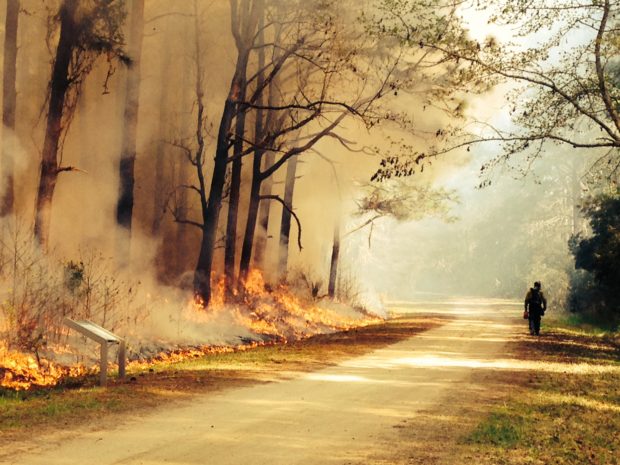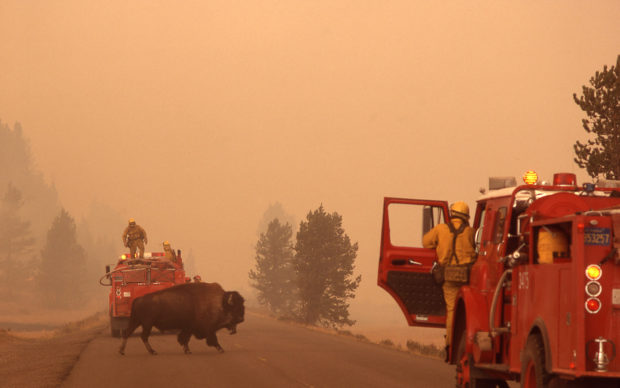We have much more to do and your continued support is needed now more than ever.
Red Moon Rising: The Growing Threat of Megafires

As my truck crested the Hoback rim and I rolled into the upper Green River basin, I couldn’t wait to see the full moon rising over the Wind River Mountains. But what I saw was both strikingly beautiful and frightening.
Smoke from this summer’s raging wildfires in Montana, Oregon, and Washington turned the full moon into an unnerving red orb – like a glowing stop sign warning those trying to traverse the landscape. Instead of providing a dramatic backlight to the stunning Winds on my left, the glowing red moon hovered ominously over a countryside completely obscured by smoke.
Except one unnatural part of the setting was still brightly visible to my right: thousands of gas wells on the Pinedale Anticline and the Jonah Field lighting up the sagebrush sea like Christmas trees. These wells are partly responsible for the climate change which is contributing to more and worse wildfires. They also fragment the same habitat the wildlife bridges and tunnels I had just driven under and over were trying to reconnect for pronghorn, mule deer, sage-grouse, and too many other species to name.
Tell Congress now to pass the Wildfire Disaster Funding Act HR2862/S1842!
The next morning, I flew out of my hotel bed in anticipation of the day’s adventure: an overflight of the Red Desert to Hoback mule deer migration corridor – the longest mule deer migration corridor on earth. The National Wildlife Federation and Wyoming Wildlife Federation planned this aerial tour to show to local reporters key landscape features that we’re working to protect through an update to the Rock Springs, Wyoming Bureau of Land Management Resource Management Plan.
Once again, I couldn’t wait to see the mighty Winds, a mountain range so substantial you can see it from space. Once again, smoke from Western wildfires obscured our view. Yes, we could make out the stunning scenery of southwest Wyoming directly below our small Eco Flight plane. But we couldn’t see the Winds, even though they were only a dozen miles away.

Increased “Mega” Fires
Here’s the thing: missing views is the least of our concerns when it comes to wildfire. While fire has always played an important and beneficial role in habitat across America, the stress of climate change – which causes in hotter weather and heat waves, more frequent droughts, low snow-pack, and early snow melt –– adds up to conditions that extend fire seasons and spike the risk of more frequent, larger, and more severe wildfires. Combined with forest mismanagement, overly aggressive fire suppression, and poor development decisions, this has set the stage for potentially severe or “mega” fires, with serious consequences for wildlife and communities in harm’s way, as well as ballooning firefighting costs.
I experienced this personally last summer. Last August, when I picked my then seven-year-old daughter Piper up from summer camp, she shifted uncomfortably in her car seat and said, “Daddy, I’m scared. Is the fire going to burn down town?”
Massive billows of smoke from the Cliff Creek fire towered over the ridge above our home in Jackson, Wyoming across the valley, concealing the mountains beyond and engulfing town in a menacing dark cloud.
“No kiddo, town will be fine,” I said as I masked my own uncertainty.
A few days later I found myself more uncertain. Firefighters were concerned that a potential wind shift could blow the fire into the Cache Creek drainage and funnel it straight toward the town of Jackson. Fortunately, this didn’t happen, and thanks to the heroic efforts of many firefighters, the Cliff Creek fire was contained.
Across North America last summer, things weren’t much better. In San Bernardino County, California, 82,000 people were ordered to leave their homes as an explosive wildfire “hit with an intensity that we hadn’t seen before,” according to one fire official. Last spring, an unprecedented wildfire that grew to more than 1 million acres forced 80,000 people to evacuate Fort McMurray, Canada, before burning thousands of homes to the ground. In November 2016, a fire started in Great Smoky Mountains National Park and quickly spread to the towns of Gatlinburg and Pigeon Forge, Tennessee. The Gatlinburg fire burned 1,700 structures, caused 14,000 to evacuate, and resulted in the death of 14 people – the deadliest the state has ever experienced.

Then came the summer of 2017, and the megafires continued their fury. At one point this summer, 1.6 million acres of wildfires raged across 10 states. Ash fell like rain in Seattle and Portland, two of the dampest places on the planet. People in Missoula, Montana had to spend nearly all summer indoors due to air too dangerous to breathe. The Governor of California declared a state of emergency for Los Angeles County as over 1,000 firefighters battled an immense blaze near Burbank. And right now, deadly megafires have literally exploded and raced along the landscape in northern California.
“Mega” Fire Impact
Of course, there have always been fires, especially in the West. And many of these fires are beneficial as they create a mosaic across the landscape that contains multiple plant communities at various growth stages, boosting wildlife diversity.
But the massive wildfires we’re dealing with now have burned larger areas more frequently and for longer durations than in the recent past. When megafires burn over vast expanses and at high heat, they can severely harm wildlife habitat. For example, the 2011 Las Conchas fire in New Mexico burned more than 156,000 acres of forest and scrubland so intensely that only bare dirt and tree stumps were left in its wake. That landscape may never fully recover.

We know what’s causing these megafires. Hotter, drier conditions from climate change are reducing the moisture levels in soils. These hotter conditions allow fauna like bark beetles and flora like cheatgrass to spread and weaken the resilience of larger natural areas, setting the stage for stronger fires. And inadequate funding and governmental red tape hinder forest management and restoration efforts, making our forests more susceptible to megafires.
Fortunately, we know what we should do to address the growing threat of megafires. We should fix the flawed federal firefighting budget, accelerate forest restoration and management, implement thoughtful climate adaptation and resilience practices, and require a dramatic reduction in climate-altering carbon emissions.
All of this is why the National Wildlife Federation recently released Megafires: The Growing Risk to America’s Forests, Communities and Wildlife from Bigger, Hotter Wildfires. This report explains the problem of megafires and offers constructive and bipartisan solutions. Click here to read the report and learn more about how you can help address the crisis of megafires.
And, most urgently I ask that you contact your Senators today to urge them to immediately pass legislation that will ensure federal agencies have the funds they need to both fight forest fires and manage forests to improve wildlife habitat and reduce the likelihood of future fires. So much of our treasured public lands and forests are at risk from megafires, and we need more resources to fight and prevent these fires wisely.
Tell Congress now to pass the Wildfire Disaster Funding Act HR2862/S1842!





















